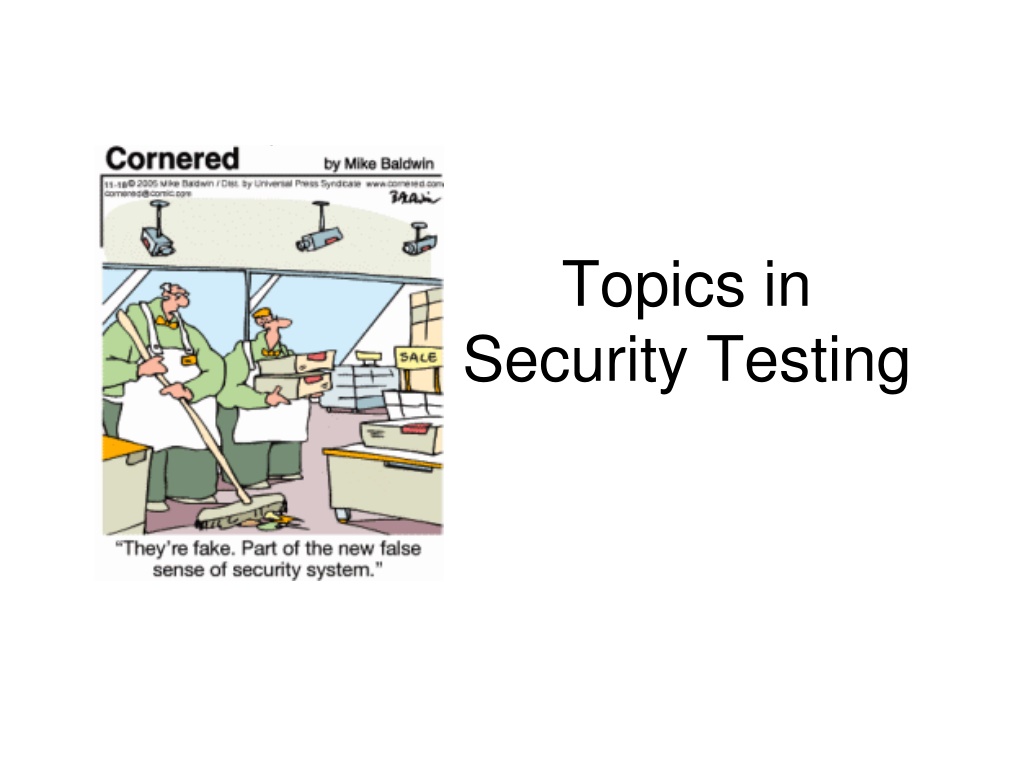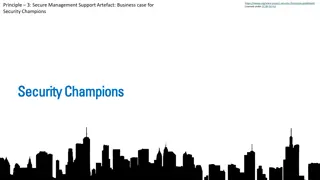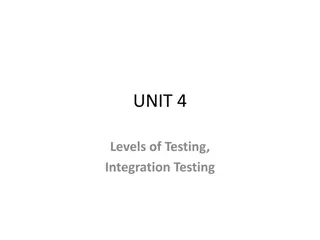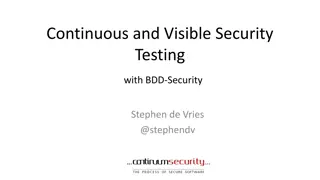Understanding Security Testing and Architecture
Explore the fundamentals of security testing, computer security goals, software security approach, and security architecture. Learn about securing computer assets, verifying trustworthiness of security mechanisms, and validating security architecture through threat modeling. Enhance your knowledge of safeguarding systems against unauthorized access and malicious software.
Download Presentation

Please find below an Image/Link to download the presentation.
The content on the website is provided AS IS for your information and personal use only. It may not be sold, licensed, or shared on other websites without obtaining consent from the author. Download presentation by click this link. If you encounter any issues during the download, it is possible that the publisher has removed the file from their server.
E N D
Presentation Transcript
Topics in Security Testing
Computer Security The goal of computer security is to protect computer assets (e.g., servers, applications, web pages, data) from: corruption unauthorized access denial of authorized access malicious software Security is strengthened by: physically limiting the access of computers to trusted users hardware mechanisms (e.g., biometrics) operating system mechanisms that impose rules on untrusted programs (e.g., role-based access control) anti-virus software to detect malware secure coding techniques (e.g., array bounds checking) to make code less vulnerable to security attacks. 2
Approach to Software Security Verify that security mechanisms are trustworthy Verify that security architecture adheres to the security policy Verify that the applications that constitute the system are trustworthy i.e., they have been developed using secure coding practices, or they are not malware. 3
Security Architecture A security architecture is a specification that is used as a guide to enforce security constraints It specifies where security mechanisms (e.g., encryption, firewalls) need to be positioned in the software architecture The quality of a security architecture also depends on the security of the applications that constitute the system 4
Security Architecture Security architecture describes the position of security mechanisms in the software architecture and comprises: subsystems e.g., web servers, application servers, DBMS, directories, web applications, and legacy applications communication links between the subsystems e.g., local or remote function calls and protocols (SSL, HTTPS, LDAP) position of security mechanisms e.g., authentication and authorization points, encryption methods, audit, logging, monitoring, intrusion detection, registration, backup, recovery 5
Example of a Security Architecture 6
Validating Security Architecture There are many security faults that arise from a poorly designed security architecture, e.g., unauthorized access to data and applications confidential and restricted data flowing as unencrypted text over network connections Security architecture is validated using a process called threat modeling. Threat modeling is typically a manual (i.e., not automated) inspection process, similar to code and requirements inspection. 7
Threat modeling Threat Modeling is a process for evaluating a software system for security issues. It is a variation of the code and specification inspections/verification processes discussed earlier in the course. The goal is for a review team to look for software features that vulnerable from a security perspective. Threat modeling is not the responsibility of a software tester, although testers may be involved in the security review team.
Threat modeling process (1) Assemble the treat modeling team Include security experts and consultants Identify the assets E.g., credit card numbers, social security numbers, computing resources, trade secrets, financial data Create an architecture overview Define the architecture and identify the trust boundaries and authentication mechanisms Decompose the application E.g., identify data flows, encryption processes, password flows.
Threat modeling process (2) Identify threats E.g., can data be viewed, changed? Limit access of legitimate users? Unauthorized access of the system? Document threats E.g., describe threat, target, form of attack, counter- measures to prevent an attack, etc. Rank threats (scale: low, medium, high) Damage potential E.g., property, data integrity, financial loss Reproducibility E.g., probability that an attempt to compromise the system will succeed Exploitability/Discoverability E.g., is it difficult to hack into the system? Affected users How many users will be affected? Who are these users? Are they important?
What is Malware? Malware (malicious software) is any program that works against the interest of the system s user or owner. Question: Is a program that spies on the web browsing habits of the employees of a company considered malware? What if the CEO authorized the installation of the spying program? https://en.wikipedia.org/wiki/Spyware
Uses of Malware Why do people develop and deploy malware? Financial gain Psychological urges and childish desires to beat the system . Access private data
Typical purposes of Malware Backdoor access: Attacker gains unlimited access to the machine. Denial-of-service (DoS) attacks: Infect a huge number of machines to try simultaneously to connect to a target server in hope of overwhelming it and making it crash. Vandalism: E.g., defacing a web site. Resource Theft: E.g., stealing other user s computing and network resources, such as using your neighbors Wireless Network. Information Theft: E.g., stealing other user s credit card numbers.
Types of Malware Viruses Worms Trojan Horses Backdoors Mobile code Adware Sticky software
Origin of the term computer virus The term computer virus was first used in an academic publication by Fred Cohen in his 1984 paper Experiments with Computer Viruses. However, a mid-1970s science fiction novel by David Gerrold, When H.A.R.L.I.E. was One, includes a description of a fictional computer program called VIRUS. John Brunner's 1975 novel The Shockwave Rider describes programs known as tapeworms which spread through a network for deleting data. The term computer virus also appears in the comic book Uncanny X-Men in 1982.
The first computer viruses A program called Elk Cloner is credited with being the first computer virus to appear "in the wild". Written in 1982 by Rich Skrenta, it attached itself to the Apple DOS 3.3 operating system and spread by floppy disk. The first PC virus was a boot sector virus called (c)Brain, created in 1986 by two brothers, Basit and Amjad Farooq Alvi, operating out of Lahore, Pakistan.
Worms Worms are malicious programs that use the Internet to spread. Similar to a virus, a worm self-replicates. Unlike a virus, a worm does not need human intervention to replicate. Worms have the ability to spread uncontrollably in a very brief period of time. Almost every computer system in the world is attached to the same network.
Worms: Operation A worm may spread because of a software vulnerability exploit: Takes advantage of the OS or an application program with program vulnerabilities that allow it to hide in a seemingly innocent data packet. A worm may also spread via e-mail. Mass mailing worms scan the user s contact list and mail themselves to every contact on such a list. In most cases the user must open an attachment to trigger the spreading of the worm (more like a virus).
Trojan horses A Trojan Horse is a seemingly innocent application that contains malicious code that is hidden somewhere inside it. Trojans are often useful programs that have unnoticeable, yet harmful, side effects.
Trojan horses: Operation (1) Embed a malicious element inside an otherwise benign program. The victim: 1. receives the infected program, 2. launches it, 3. remains oblivious of the fact that the system has been infected. The application continues to operate normally to eliminate any suspicion.
Trojan horses: Operation (2) Fool users into believing that a file containing a malicious program is really an innocent file such as a video clip or an image. This is easy to do on MS Windows because file types are determined by their extension as opposed to examining the file headers. E.g., A Great Picture.jpg .exe The .exe might not be visible in the browser. The Trojan author can create a picture icon that is the default icon of MS Windows for .jpg files.
Backdoors A backdoor is malware that creates a covert access channel that the attacker can use for: connecting, controlling, spying, or otherwise interacting with the victim s system.
Backdoors: Operation Backdoors can be embedded in actual programs that, when executed, enable the attacker to connect to and to use the system remotely. Backdoors may be planted into the source code by rogue software developers before the product is released. This is more difficult to get away with if the program is open source.
Mobile code Mobile code is a class of benign programs that are: meant to be mobile, meant to be executed on a large number of systems, not meant to be installed explicitly by end users. Most mobile code is designed to create a more active web browsing experience. E.g., Java applets, ActiveX controls.
Mobile code (Contd) Java scripts are distributed in source code form making them easy to analyze. ActiveX components are conventional executables that contain native IA-32 machine code. Java applets are in bytecode form, which makes them easy to decompile.
Mobile code: Operation Web sites quickly download and launch a program on the end user s system. User might see a message that warns about a program that is about to be installed and launched. Most users click OK to allow the program to run. They may not consider the possibility that malicious code is about to be downloaded and executed on their system.
Adware Adware is a program that forces unsolicited advertising on end users. Adware is a new category of malicious programs that has become very popular. Adware is usually bundled with free software that is funded by the advertisements displayed by the Adware program.
Adware: Operation (1) The program gathers statistics about the end user s browsing and shopping habits. The data might be transferred to a remote server. Then the Adware uses the information to display targeted advertisements to the end user.
Adware: Operation (2) Adware can be buggy and can limit the performance of the infected machine. E.g., MS IE can freeze for a long time because an Adware DLL is poorly implemented and does not use multithreading properly. Ironically, buggy Adware defeats the purpose of the Adware itself.
Sticky software Sticky software implements methods that prevent or deter users from uninstalling it manually. One simple solution is not to offer an uninstall program. Another solution in Windows involves: installing registry keys that instruct Windows to always launch the malware as soon as the system is booted. The malware monitors changes to the registry and replace the keys of they are deleted by the user. The malware uses two mutually monitoring processes to ensure that the user does not terminate the malware before deleting the keys.
Future Malware Today s malware is just the tip of the iceberg. The next generation of malware may take control of the low levels of the computer system (e.g., BIOS, Firmware). The antidote software will be in the control of the malware Also the theft of valuable information can result in holding it for ransom.
Information-stealing worms Present-day malware does not take advantage of cryptography much. Asymmetric encryption creates new possibilities for the creation of information-stealing worms. A worm encrypts valuable data on the infected system using an asymmetric cipher and hold the data as ransom.
Information-stealing worms:Operation The Kleptographic worm embeds a public encryption key in its body. It starts encrypting every bit of valuable data on the host using the public key. Decryption of the data is impossible without the private key. Attacker blackmails the victim demanding ransom. Attacker exchanges the private key for the ransom while maintaining anonymity. Theoretically possible using zero-knowledge proofs Attacker proves that he has the private key without exposing it. 1. 2. 3. 4. 5.
BIOS/Firmware Malware Antivirus programs assume that there is always some trusted layer of the system. Na ve antivirus programs scan the hard drive for infected files using the high-level file-system service. A clever virus can intercept file system calls and present to the virus with fake versions (original/uninfected) of the files on disk. Sophisticated antivirus programs reside at a low enough level (in OS kernel) so that malware cannot distort their view of the system.
BIOS/Firmware Malware: Operations (1) What is the malware altered an extremely low level layer of the system? Most CPUs/hardware devices run very low-level code that implements each assembly language instruction using low level instructions (micro-ops). The micro-ops code that runs inside the processor is called firmware. Firmware can be updated using a firmware-updating program.
BIOS/Firmware Malware: Operations (2) Malicious firmware can (in theory) be included in malware that defeats antivirus programs. The hardware will be compromised by the malicious firmware. Not easy to do in practice because firmware update files are encrypted (private key inside the processor).
Antivirus programs Antivirus programs identify malware by looking for unique signatures in the code of each program (i.e., potential virus) on a computer. A signature is a unique sequence of code found in a part of the malicious program. The antivirus program maintains a frequently updated database of virus signatures. The goal is for the database to contain a signature for every known malware program. Well known antivirus software includes: Symantec (http://www.symantec.com) McAfee (http://www.mcafee.com)
Polymorphic viruses Polymorphism is a technique that thwarts signature-based identification programs. Polymorphic viruses randomly encode or encrypt the program code in a semantics- preserving way. The idea is to encrypt the code with a random key and decrypt it at runtime. Each copy of the code is different because of the use of a random key.
Polymorphic viruses: Decryption technique A decryption technique that polymorphic viruses employ involves XORing each byte with a randomized key that was saved by the parent virus. The use of XOR-operations has the additional advantage that the encryption and decryption routine are the same: a xor b = c c xor b = a
Polymorphic viruses: Weaknesses Many antivirus programs scan for virus signatures in memory. I.e., after the polymorphic virus has been decrypted. If the virus code that does the decryption is static, then the decryption code can be used as a signature. This limitation can be addressed (somewhat) if the decryption code is scrambled (superficially): randomize the use of registers, add no-ops in the code,
Metamorphic viruses Instead of encrypting the program s body and making slight alterations in the decryption engine, alter the entire program each time it is replicated. This makes it extremely difficult for antivirus writers to use signature-matching techniques to identify malware. Metamorphism requires a powerful code analysis engine that needs to be embedded into the malware.
Metamorphic viruses: Operation Metamorphic engine scans the code and generates a different version of it every time the program is duplicated. The metamorphic engine performs a wide variety of transformations on the malware and on the engine itself. Instruction and register randomization. Instruction ordering Reversing (negating) conditions Insertion of garbage instructions Reordering of the storage location of functions
Timeline of famous malware (1982-1988) [wikipedia] 1982 Elk Cloner, written for Apple II systems, is credited with being the first computer virus. 1987 (c)Brain, the first virus written for PCs. SCA, a boot sector virus for Amiga appears, immediately creating a pandemic virus-writer storm. A short time later, SCA releases another, considerably more destructive virus, the Byte Bandit. 1988 Morris worm infects DEC VAX machines connected to the Internet and becomes the first worm to spread extensively.
Timeline of famous malware (1998-2000) [wikipedia] 1998 CIH virus version 1. 1999 Melissa worm is released, targeting Microsoft Word and Outlook-based systems, and creating considerable network traffic. 2000 The VBS/Loveletter worm, also known as the "I love you" virus appeared. As of 2004, this was the most costly virus to business, causing upwards of 10 billion dollars in damage.
Timeline of famous malware (2001) [wikipedia] Klez worm. Nimda worm. Code Red II worm (spreads in China, attacks Microsoft's Internet Information Services. Sircam worm (spreads through e-mails and unprotected network shares). Sadmind worm (spreads by exploiting holes in both Sun Microsystem's Solaris and MS IIS). Raman worm (similar to the Morris worm infected only Red Hat Linux machines running version 6.2 and 7.0, using three vulnerabilities in wu- ftpd,rpc-statd and lpd.
Timeline of famous malware (2003) [wikipedia] Sober worm is first seen and maintains its presence until 2005 with many new variants. Sobig worm (technically the Sobig.F worm) spread rapidly via mail and network shares. Blaster worm also know as the Lovesan worm spread rapidly by exploiting MS computers. SQL slammer worm also known as the Sapphire worm, attacked vulnerabilities in Microsoft SQL Server and MSDE, causes widespread problems on the Internet.
Timeline of famous malware (2004) [wikipedia] Sasser worm emerges by exploiting a vulnerability in LSASS, causes problems in networks. Witty worm is a record breaking worm in many regards. It exploited holes in several Internet Security Systems (ISS) products. it was the first internet worm to carry a destructive payload and it spread rapidly using a pre-populated list of ground- zero hosts. MyDoom emerges, and currently holds the record for the fastest-spreading mass mailer worm.
Timeline of famous malware (2005) [wikipedia] Zotob worm, the effect was overblown because several United States media outlets were infected.























